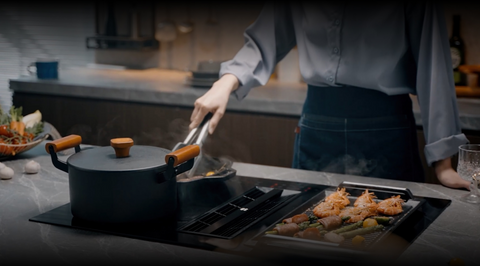A downdraft cooktop is a cooking appliance designed to integrate cooking and ventilation in a single unit. The downdraft stove seamlessly incorporates the ventilation system within the cooking surface itself, negating the necessity for an overhead vent. These systems effectively trap and redirect smoke, steam, grease particles, and odors right at the cooking surface, channeling them downward and away from the kitchen before they have a chance to disperse into the air. Unlike traditional cooktops that rely on overhead range hoods or ventilation systems to whisk away cooking byproducts, downdraft cooktops feature a built-in ventilation system. Given that downdraft ventilation systems eliminate the need for an overhead vent, they are an excellent choice for open floor plans, kitchen island cooktop installations, and kitchens that lack the space or infrastructure for traditional range hoods.

How Do Downdraft Cooktops Work?
Traditional cooktops and ranges are primarily designed as heat sources for cooking and lack integrated ventilation systems. One typically needs to invest in a separate range hood to achieve proper kitchen ventilation. In contrast, downdraft cooktops seamlessly merge the functionalities of these two appliances. They feature built-in vents along the cooking surface's edges or at its center, effectively providing ventilation without needing a separate range hood. This downdraft technology is versatile and compatible with various cooking methods, including gas, electric, and induction hob, making it a versatile choice for kitchens of any culinary preference.
Capturing Cooking Byproducts: When you cook on a induction cooktop with downdraft, the byproducts such as cooking odors, smoke, and grease naturally rise into the air.
Activated Ventilation: To capture these byproducts, you activate the downdraft ventilation system. This can usually be done via a control panel on the cooktop or through a remote control.
Rising Airflow: Once activated, the downdraft system generates air flow from the cooktop's surface. It creates a suction effect, drawing in the cooking byproducts.
Capture and Filtration: The rising airflow carries the cooking byproducts into the concealed ventilation system. This system typically includes a series of filters, such as mesh and charcoal filters, which capture and trap grease and odors.
How to Cook with Downdraft Cooktop
To ensure optimal cooking outcomes, activating the downdraft ventilation fan before switching on any of the electric cooktop's heating elements is advisable. When using taller pots, it's best to position them on burners in close proximity to the ventilation source. Keep in mind that you might need to set a higher heat level during cooking to offset the airflow across the cooktop surface. However, be cautious with higher fan speeds, as they could potentially draw heat away from your cookware.
Conclusion:
Downdraft cooktops represent a modern and efficient solution for kitchen ventilation. Their integrated design, space-saving benefits, and effective ventilation make them a compelling choice for many homeowners. Like our Ciarra ONE downdraft induction cooktop blend cooking and ventilation in a single unit, eliminating the need for overhead vents. They capture cooking byproducts, like smoke and odors, and channel them downward, making them ideal for open kitchens and islands. To use them effectively, activate the ventilation before cooking and consider pot placement and heat adjustments. Downdraft cooktops are a modern, space-saving kitchen solution.

